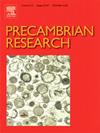华北克拉通北部古元古代柳营角闪岩弧的成因及其构造演化意义
IF 3.2
2区 地球科学
Q2 GEOSCIENCES, MULTIDISCIPLINARY
引用次数: 0
摘要
了解华北克拉通北部古元古代构造形态是重建华北克拉通前寒武纪构造史的关键。本研究综合了河北流营超镁铁质杂岩的野外地质观测、岩石学资料、U-Pb年代学、锆石的Lu-Hf同位素分析,以及包括Sr-Nd同位素在内的矿物和全岩地球化学特征。我们的目标是加强对克拉通北缘构造史的了解。杂岩体由角闪岩和斜长石角闪岩组成,呈火成岩堆积结构。超镁铁质杂岩的锆石U-Pb数据确定了3组不同的年龄:2211 ~ 2343 Ma、1761 ~ 1999 Ma和246 ~ 310 Ma,对应于地壳热事件引起的岩浆结晶和变质作用。岩石主要元素与含水弧岩浆分异趋势一致。它们表现出大离子亲石元素富集、高场强元素亏缺的特点。中下地壳深度(18 ~ 23 km)、温度为966 ~ 996℃,H2O含量为7.3 ~ 8.1 wt%的弧岩浆分馏结晶形成角闪岩富集弧堆。锆石εHf(t)值(-5.96 ~ + 9.05)与富集的Sr-Nd同位素组成((87Sr/86Sr)i = 0.704185 ~ 0.705932, εNd(t) = - 14.6 ~ - 5.68, (87Sr/86Sr)amp = 0.705110 ~ 0.705846)解耦合,表明地幔源区为俯冲变质地幔源,包含5 ~ 10%的俯冲板块衍生熔体和流体。北克拉通北部是古俯冲带之上的大陆弧,其规模与现代安第斯山脉约2.2 Ga相似。克拉通与西伯利亚板块之间的洋板俯冲作用导致交代地幔楔部分熔融,形成古元古代角闪岩弧堆积。本文章由计算机程序翻译,如有差异,请以英文原文为准。
Petrogenesis of the Paleoproterozoic Liuying hornblendite arc cumulates and implications for the tectonic evolution of the northern North China Craton
Understanding the Paleoproterozoic configuration of the northern North China Craton (NCC) is crucial for reconstructing its Precambrian tectonic history. This study integrates geological field observations, petrological data, U-Pb geochronology, and Lu-Hf isotopic analysis of zircons, alongside mineral and whole-rock geochemistry, including Sr-Nd isotopes from the Liuying ultramafic complex in Hebei Province. Our goal is to enhance the understanding of the tectonic history of the craton’s northern margin. The complex is composed of hornblendite and plagioclase hornblendite, showing igneous cumulate texture. Zircon U-Pb data from the ultramafic complex define three distinct groups of ages: 2211–2343 Ma, 1761–1999 Ma, and 246–310 Ma, corresponding to magma crystallization and metamorphism resulted from crustal thermal events. The major elements of rocks align with the differentiation trend of hydrous arc magmas. They display characteristics of enrichment in large ion lithophile elements and depletion in high field strength elements. Fractional crystallization of arc magmas with H2O of 7.3–8.1 wt% at middle-lower crust depths (18–23 km) and 966–996 °C formed amphibole-enrichment arc cumulates. The zircon εHf(t) values (–5.96 to + 9.05) are decoupled from enriched Sr-Nd isotopic compositions ((87Sr/86Sr)i = 0.704185–0.705932, εNd(t) = −14.6 to −5.68, (87Sr/86Sr)amp = 0.705110–0.705846), suggesting a subduction-modified mantle source, incorporating 5–10 % subduction slab-derived melts and fluids. The northern part of the NCC was a continental arc above a paleo-subduction zone on a scale similar to the modern Andes at ca. 2.2 Ga. The oceanic slab subduction between the craton and the Siberian segment resulted in partial melting of metasomatized mantle wedge to form Paleoproterozoic hornblendite arc cumulates.
求助全文
通过发布文献求助,成功后即可免费获取论文全文。
去求助
来源期刊

Precambrian Research
地学-地球科学综合
CiteScore
7.20
自引率
28.90%
发文量
325
审稿时长
12 months
期刊介绍:
Precambrian Research publishes studies on all aspects of the early stages of the composition, structure and evolution of the Earth and its planetary neighbours. With a focus on process-oriented and comparative studies, it covers, but is not restricted to, subjects such as:
(1) Chemical, biological, biochemical and cosmochemical evolution; the origin of life; the evolution of the oceans and atmosphere; the early fossil record; palaeobiology;
(2) Geochronology and isotope and elemental geochemistry;
(3) Precambrian mineral deposits;
(4) Geophysical aspects of the early Earth and Precambrian terrains;
(5) Nature, formation and evolution of the Precambrian lithosphere and mantle including magmatic, depositional, metamorphic and tectonic processes.
In addition, the editors particularly welcome integrated process-oriented studies that involve a combination of the above fields and comparative studies that demonstrate the effect of Precambrian evolution on Phanerozoic earth system processes.
Regional and localised studies of Precambrian phenomena are considered appropriate only when the detail and quality allow illustration of a wider process, or when significant gaps in basic knowledge of a particular area can be filled.
 求助内容:
求助内容: 应助结果提醒方式:
应助结果提醒方式:


